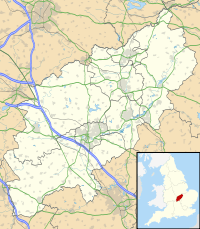Benefield Castle facts for kids
Quick facts for kids Benefield Castle |
|
|---|---|
| Lower Benefield, Northamptonshire, England | |
| Coordinates | 52°29′4.56″N 0°32′52.69″W / 52.4846000°N 0.5479694°W |
| Type | Castle |
| Site information | |
| Condition | Earthworks |
Benefield Castle was an old castle located in the village of Lower Benefield, in Northamptonshire, England. It stood between the towns of Corby and Oundle. Today, only its earthworks remain, showing us where this historic site once stood.
Contents
The Story of Benefield Castle
Benefield Castle is known as a "ring work." This type of castle was built in the Middle Ages. It usually had buildings inside a large ditch. Around the ditch, there would be a strong timber fence called a palisade or a stone wall.
Building the Castle
Experts believe Benefield Castle was built in the 1100s. We don't know the exact year it was finished. However, old papers from the 1200s mention the castle by name. It might have been one of many forts built during a difficult time in England. This period was called "The Anarchy." It happened when King Stephen ruled, from 1138 to 1144.
Royal Takeover and Conflict
In 1208, King John took control of the castle. Its owner, Hugh de Lisurs, had not paid his debts to the king.
Later, in 1264, there was a big battle called the Battle of Lewes. After this battle, King Henry III told his knights to be peaceful. He had made an agreement with some powerful lords, called barons.
A year later, in 1265, something interesting happened. Soldiers loyal to Edward, who would later become king, were staying at the castle. They attacked a nearby place called Biggin Manor. Then, they crossed the river to steal cattle from Oundle. But the people of Oundle fought back! They managed to get many of their cattle back.
The Castle's End
Soon after this incident, Benefield Castle was taken down. By 1298, old documents called it "an old castle." By 1315, no buildings were left standing. Papers from that time only mentioned the site where the castle used to be.
In 1378, the site was still described as a ruin. A writer named Leland mentioned the ruins in 1535. He wrote about "the ditch and ruins of an old castle." In 1724, another writer, Bridges, said a part of the wall was still standing. It surrounded about one acre of land.
The manor house, a large house near the castle, lasted much longer. It was still standing in 1445. By the mid-1700s, only a stone wall remained of the castle. Maps from the 1800s show that the main entrance, or gatehouse, was on the eastern side. It faced the manor farm.
What Remains Today
Today, you can still see some of the earthworks of Benefield Castle. These are mounds and ditches in the ground. They are on high ground on the western side of Lower Benefield.
Archaeologists have found signs of old buildings there. These include both homes and defensive structures. They were built on a large, raised area. This area was about 60 meters long and 50 meters wide. It was also about 2 meters high.
The large ditch, which was common for these castles, is still there. It is up to 10 meters wide and 3 meters deep. However, the southern part of the ditch has been filled in over time.


